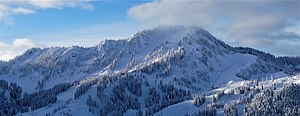Cowboy Mountain
Cowboy Mountain is a 5,853 ft (1,780 m) mountain summit located in northeast King County of Washington state.[3] It is situated at Stevens Pass, on land managed by Mount Baker-Snoqualmie National Forest. This mountain is best known for ski runs on its north slopes which are part of the Stevens Pass Ski Area. Cowboy Mountain is part of the Chiwaukum Mountains, which are a subset of the Cascade Range. Its nearest higher neighbor is Big Chief Mountain, 1.9 mi (3.1 km) to the northeast, and the Pacific Crest Trail passes through the saddle between these two mountains.[1] Precipitation runoff from the peak drains into headwaters of the Tye River, which in turn is a tributary of the Skykomish River. The longest railroad tunnel in the United States, the Cascade Tunnel, was bored directly under Cowboy Mountain, as a response to deadly avalanches that threatened trains of the Great Northern Railway. The deadliest avalanche in the history of the United States, the 1910 Wellington avalanche, occurred approximately two miles west of Cowboy Mountain.
| Cowboy Mountain | |
|---|---|
 Cowboy Mountain, north aspect | |
| Highest point | |
| Elevation | 5,853 ft (1,784 m) [1] |
| Prominence | 773 ft (236 m) [1] |
| Parent peak | Big Chief Mountain (5,858 ft)[1] |
| Isolation | 1.9 mi (3.1 km) [2] |
| Coordinates | 47°43′56″N 121°06′09″W [1] |
| Geography | |
 Cowboy Mountain Location in Washington  Cowboy Mountain Location in the United States | |
| Location | King County Washington state, U.S. |
| Parent range | Chiwaukum Mountains Wenatchee Mountains Cascade Range |
| Topo map | USGS Stevens Pass |
| Climbing | |
| Easiest route | class 2 Scrambling |
Climate
Cowboy Mountain is located in the marine west coast climate zone of western North America.[4] Most weather fronts originate in the Pacific Ocean, and travel northeast toward the Cascade Mountains. As fronts approach, they are forced upward by the peaks of the Cascade Range, causing them to drop their moisture in the form of rain or snowfall onto the Cascades (Orographic lift). As a result, the west side of the Cascades experiences high precipitation, especially during the winter months in the form of snowfall. During winter months, weather is usually cloudy, but, due to high pressure systems over the Pacific Ocean that intensify during summer months, there is often little or no cloud cover during the summer.[4] Because of maritime influence, snow tends to be wet and heavy, resulting in high avalanche danger.[4]
References
- "Cowboy Mountain, Washington". Peakbagger.com.
- "Cowboy Mountain - 5,853' WA". listsofjohn.com. Retrieved 2020-07-02.
- "Cowboy Mountain". Geographic Names Information System. United States Geological Survey. Retrieved 2020-07-02.
- Beckey, Fred W. Cascade Alpine Guide, Climbing and High Routes. Seattle, WA: Mountaineers Books, 2008.
External links
- Weather forecast: Cowboy Mountain